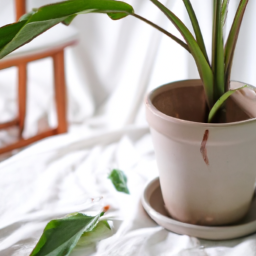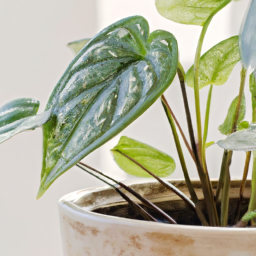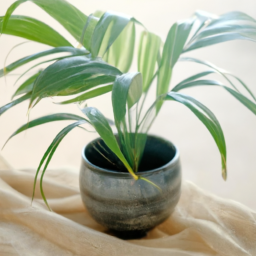
Are you struggling with Indoor Plants Issues? You’re not alone. Many plant enthusiasts face challenges when it comes to caring for their indoor greenery. From pests to diseases to environmental factors, there are a variety of issues that can arise when trying to maintain a thriving indoor garden. In this blog post, we’ll explore some common problems that indoor plant owners encounter and provide tips and solutions to help you overcome them. Whether you’re a seasoned plant parent or just starting out, this guide will help you keep your indoor plants healthy and happy.
Common Indoor Plants Issues and How to Solve Them
Identifying the Problem
Indoor plants can bring beauty and life to any space, but they can also come with their fair share of issues. One of the most common problems that indoor plants face is overwatering. This can lead to root rot, yellowing leaves, and ultimately the death of the plant. On the other hand, underwatering can also be a problem, causing wilting and dry, crispy leaves.
Another issue that indoor plants often face is inadequate light. Different plants have different light requirements, so it’s important to place your plant in a spot where it will receive the right amount of sunlight. Too much sun can lead to scorched leaves, while too little can cause leggy growth and a lack of blooms.
Pests are another common problem for indoor plants. Spider mites, aphids, and mealybugs are just a few of the pests that can wreak havoc on your plants. It’s important to regularly inspect your plants for any signs of pests and take action quickly to prevent infestations from spreading.
How to Solve Common Indoor Plants Issues
To solve the issue of overwatering, it’s important to allow your plant to dry out between waterings. Make sure your plant is in a pot with good drainage, and only water when the top inch of soil is dry to the touch. If you suspect root rot, remove the plant from its pot and trim away any rotted roots before repotting in fresh soil.
For underwatering, it’s important to establish a consistent watering schedule based on your plant’s individual needs. Some plants prefer to dry out completely between waterings, while others like to stay consistently moist. Pay attention to your plant’s specific requirements and adjust your watering routine accordingly.
To address inadequate light, consider moving your plant to a spot where it will receive the right amount of sunlight. If natural light is limited in your space, you can supplement with a grow light to ensure your plant is getting the light it needs to thrive.
When it comes to pests, prevention is key. Regularly inspect your plants for any signs of pests, such as webbing, sticky residue, or tiny insects. If you do notice pests, isolate the affected plant to prevent the infestation from spreading, and treat with a natural insecticide or neem oil to get rid of the pests.
Conclusion
By being proactive and attentive to your indoor plants, you can prevent and solve common issues that may arise. Remember to water with care, provide adequate light, and keep an eye out for pests to ensure your plants stay healthy and vibrant. With a little bit of knowledge and effort, you can enjoy the beauty of indoor plants without the stress of dealing with issues.

Identifying and Treating Common Pests on Indoor Plants
Introduction
Indoor plants are a great way to add greenery and life to your home, but they can also be susceptible to pests that can harm them. Identifying and treating common pests on indoor plants is essential to keeping your plants healthy and thriving. In this guide, we will discuss some of the most common pests that can affect indoor plants and how to effectively treat them.
Identifying Common Pests
One of the most common pests that can affect indoor plants is the spider mite. These tiny pests are difficult to see with the naked eye, but they can cause significant damage to your plants by sucking out their sap. Spider mites often leave behind webbing on the leaves of plants, which is a telltale sign of their presence. Another common pest is the aphid, which are small, soft-bodied insects that feed on the sap of plants. Aphids can be found in clusters on the undersides of leaves and can cause leaves to become distorted and yellow.
Another common indoor plant pest is the mealybug, which are small, white, fluffy insects that feed on plant sap. Mealybugs can often be found in the crevices of plants and can cause leaves to become sticky and blackened. Thrips are another common pest that can affect indoor plants, and they are tiny, slender insects that feed on plant sap. Thrips can cause leaves to become discolored and distorted, and they can also spread diseases to plants.
Treating Common Pests
When it comes to treating common pests on indoor plants, there are several methods that can be effective. One option is to use insecticidal soap, which is a safe and effective way to control pests on indoor plants. Simply spray the insecticidal soap onto the affected plants, making sure to cover all surfaces of the leaves. Repeat the treatment every 7-10 days until the pests are gone.
Another option for treating common pests on indoor plants is to use neem oil, which is a natural insecticide that is safe for use on plants. Neem oil works by suffocating the pests and disrupting their life cycle. To use neem oil, mix it with water according to the instructions on the bottle and spray it onto the affected plants. Repeat the treatment every 7-10 days until the pests are eradicated.
For severe infestations, you may need to resort to using chemical pesticides to treat common pests on indoor plants. However, it is important to use these products carefully and according to the instructions on the label to avoid harming your plants or yourself. Always wear protective clothing and gloves when using chemical pesticides, and make sure to keep children and pets away from treated plants.
In conclusion, identifying and treating common pests on indoor plants is essential to keeping your plants healthy and thriving. By being proactive and using effective pest control methods, you can ensure that your indoor plants remain pest-free and beautiful. Remember to regularly inspect your plants for signs of pests and take action promptly if you notice any issues.

Understanding the Importance of Proper Lighting for Indoor Plants
Introduction
When it comes to caring for indoor plants, one of the most crucial factors to consider is lighting. Proper lighting is essential for the health and growth of indoor plants, as it plays a significant role in photosynthesis, the process by which plants convert light into energy. In this guide, we will delve into the importance of proper lighting for indoor plants and provide you with tips on how to ensure your plants receive the right amount of light to thrive.
Why is Proper Lighting Important?
Proper lighting is crucial for indoor plants because it directly impacts their ability to photosynthesize and grow. Without adequate light, plants will struggle to produce the energy they need to thrive, leading to stunted growth, yellowing leaves, and overall poor health. Different plants have varying light requirements, with some needing bright, direct light, while others thrive in low light conditions. Understanding the lighting needs of your indoor plants is key to ensuring they receive the right amount of light to flourish.
In addition to promoting healthy growth, proper lighting also affects the flowering and fruiting of indoor plants. Many flowering plants require specific light conditions to bloom, and inadequate light can result in a lack of flowers or fruit. By providing your plants with the right amount of light, you can encourage them to flower and produce fruit, enhancing the beauty and productivity of your indoor garden.
Another important aspect of proper lighting for indoor plants is the prevention of issues such as leggy growth and leaf drop. When plants do not receive enough light, they may become leggy, with long, weak stems and sparse foliage. Additionally, inadequate light can cause leaves to drop prematurely, leading to a loss of overall plant health. By ensuring your plants receive sufficient light, you can help prevent these common issues and promote strong, healthy growth.
Tips for Providing Proper Lighting
To ensure your indoor plants receive the proper lighting they need to thrive, consider the following tips:
1. Know Your Plant’s Light Requirements: Before bringing a new plant into your home, research its specific light requirements to determine the best placement for optimal growth. Some plants require bright, direct light, while others prefer indirect or low light conditions.
2. Rotate Your Plants: To ensure all parts of your plants receive adequate light, rotate them regularly to expose different sides to the light source. This will help prevent uneven growth and ensure all parts of the plant receive the energy they need to thrive.
3. Supplement with Grow Lights: If you have plants that require high levels of light but do not have access to natural sunlight, consider supplementing with grow lights. These artificial lights are designed to mimic the spectrum of natural sunlight and can help provide your plants with the light they need to flourish.
By following these tips and understanding the importance of proper lighting for indoor plants, you can create a healthy and thriving indoor garden that brings beauty and joy to your home. Remember to observe your plants regularly and adjust their lighting as needed to ensure they receive the optimal conditions for growth.
Let’s bring it all home
Have you been struggling to keep your indoor plants healthy and thriving? You’re not alone. Indoor plants can face a variety of issues that can hinder their growth and overall health. One common issue is overwatering, which can lead to root rot and ultimately kill your plant. It’s important to let the soil dry out between waterings to prevent this from happening.
Another common issue is lack of sunlight. Indoor plants need adequate light to photosynthesize and grow properly. If your plant isn’t getting enough light, it may become leggy or start to droop. Consider moving your plant to a brighter location or investing in a grow light to help it thrive. By addressing these common indoor plant issues, you can help your plants stay healthy and beautiful for years to come.
Here are some questions from our readers:
Q1: Why are my indoor plants turning yellow?
A1: Indoor plants can turn yellow due to overwatering, lack of sunlight, or nutrient deficiencies. Make sure you are watering your plants appropriately and providing them with enough light. Consider adding fertilizer to replenish any missing nutrients.
Q2: How can I prevent pests from infesting my indoor plants?
A2: To prevent pests from infesting your indoor plants, regularly inspect them for any signs of pests such as webs, holes in leaves, or sticky residue. You can also use natural remedies like neem oil or insecticidal soap to control pest infestations.
Q3: What should I do if my indoor plant is wilting?
A3: Wilting indoor plants are often a sign of underwatering or root rot. Check the soil moisture level and adjust your watering schedule accordingly. If root rot is present, consider repotting the plant in fresh, well-draining soil.
Q4: How can I improve the humidity levels for my indoor plants?
A4: To improve humidity levels for your indoor plants, you can place a humidifier near them, group plants together to create a microclimate, or mist the leaves regularly. You can also place a tray of water near the plants to increase humidity.
Q5: What should I do if my indoor plant is not growing or thriving?
A5: If your indoor plant is not growing or thriving, check for any issues with light, water, or nutrients. Make sure the plant is receiving adequate sunlight, water it appropriately, and consider fertilizing it to promote growth. You may also need to repot the plant if it has outgrown its current container.

James Wong is a renowned ethnobotanist, plant scientist, and local television presenter. With a passion for demystifying plant science, he is known for translating complex botanical concepts into practical advice for everyday plant enthusiasts. James’s expertise spans from traditional gardening to cutting-edge plant technologies, making his insights accessible and informative.


